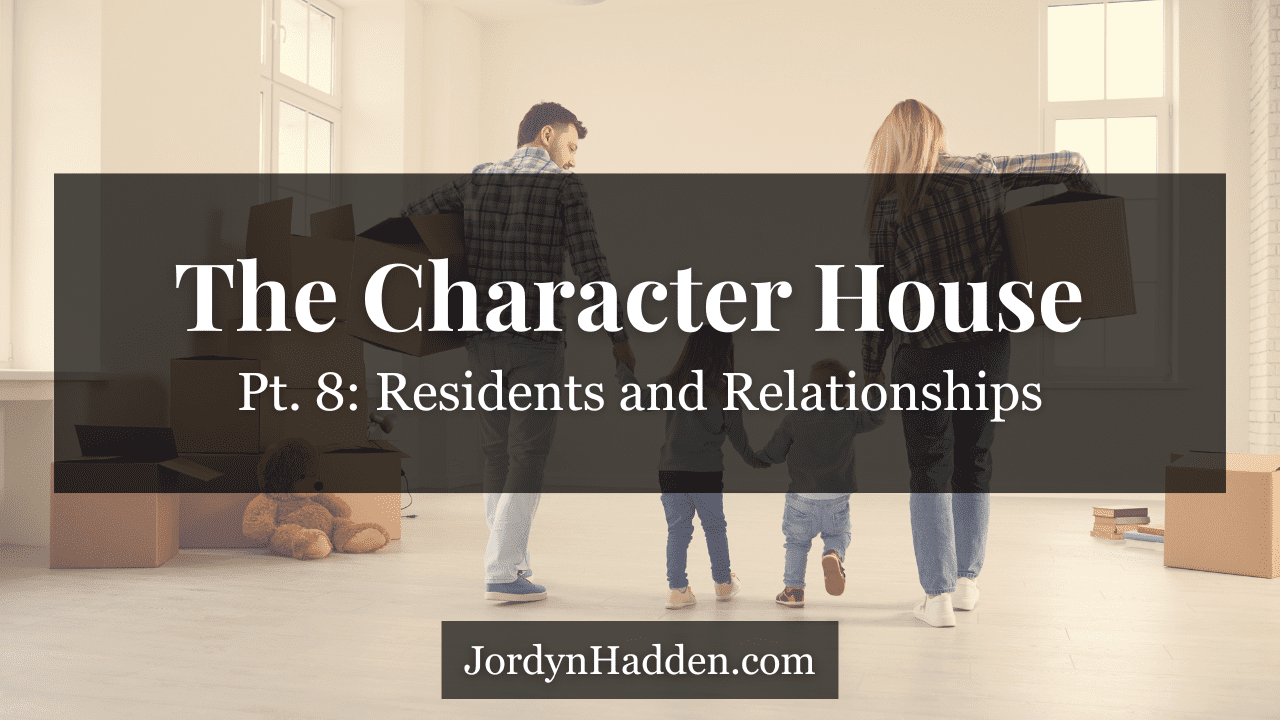What’s the only thing more exciting, more challenging, and more rewarding than developing characters?
Developing character relationships.
Continuing our Character House series, we’re going to discuss the Character Relationships, represented by the Residents of the House. With these tips in mind, you’ll be able to make your characters’ relationships detailed, enjoyable, and compelling!
Why Are Character Relationships Important?
The people who live in the house represent the character’s relationships—family relationships, friendships, romances, mentorships, rivalries, hostilities, and more.
Relationships make characters realistic, creating the illusion that the character existed long before the story begins. They make characters likable, bridging the distance between the characters and the audience.
Strong interpersonal connections develop both characters involved. Relationships can also propel the plot by motivating the character to pursue the story goal. Finally, relationships can raise the stakes. Characters have more to lose when they’re fighting for more people than just themselves.
Developing Character Relationships
You might understand two of your characters individually, but figuring out how they interact can be a challenge.
If you encounter this problem, check out Angela Ackerman and Becca Puglisi’s Relationship Thesaurus. This online tool covers over forty different relationships—siblings, neighbors, rivals, teacher and student, author and editor, etc.—and lists possible dynamics, challenges, contrasting traits, and development opportunities for each one.
To develop a character relationship, you can flesh out the following areas.
1. Create a shared history.
How did your characters meet? What events have they experienced together? Are they siblings who grew up together? Are they friends who have shared sleepovers and movie nights? Are they opponents with a rivalry spanning decades?
2. Examine the relationship from both sides.
The characters’ respective feelings, thoughts, and beliefs will shape their behavior toward each other. What qualities does each character like or dislike about the other? How would each character describe the other?
3. Add nuance.
Relationships are rarely always positive or always negative. Rivals can still harbor a degree of mutual respect, and close friends may have pet peeves about the other person.
4. Give the characters something in common.
Many relationships thrive when the characters share a history, a favorite activity, or even a common backstory event. Think about the people with whom you enjoy spending time. Do you participate in the same hobby? Do you have similar senses of humor? Do you share a love of traveling or animals? Shared interests and experiences provide characters with conversation topics and inside jokes.
5. Pair contrasting traits.
Although characters should share common traits or interests, they should also be different from each other. Contrasting traits can highlight each personality more clearly. Tessa Afshar’s Thief of Corinth contrasts Ariadne’s impulsivity and quick temper with Theo’s calmness and steadiness. This juxtaposition ensures that both siblings are distinctive characters and generates organic interpersonal conflict.
Showing Character Relationships
1. Imply the characters’ history through their interactions.
Once you develop your characters’ shared history (as described in a previous section), you can mention these details in your story. A pair of friends might have favorite activities and memories. Siblings might know exactly how to get on each other’s nerves, while a husband and wife might give each other heartfelt gifts. These interactions reveal important relationship dynamics.
In addition, small details—such as nicknames, inside jokes, birthdays, and anniversaries—can help the audience relate to the characters.
2. Put the characters through a stressful situation together.
High-pressure scenarios can strengthen relationships—whether it’s a life-or-death battle or simply a shared science project. When circumstances force the characters to rely on each other, their outward facades crumble, allowing them to get to know each other at a deeper level.
In McCall Hoyle’s Meet the Sky, Sophie and Finn must work together to survive a hurricane that strikes the Outer Banks of North Carolina. This dangerous situation forges a close connection in a way that simply meeting at a coffee shop would not.
3. Show complexity in the relationship.
Siblings might love each other but drive each other crazy. Friends might take turns encouraging each other. Rivals might come to an uneasy truce. In all types of relationships, misunderstandings and miscommunications abound.
The siblings, friends, parents, and rivals should have lives of their own. Give the best friend a chance to discuss her own problems with the protagonist. Give the older brother a hobby that he shares with the hero. When you give side characters lives of their own, the depth of the relationship will delight readers.
4. Show the relationship changing throughout the story.
Just like real-life relationships, the best fictional relationships change throughout the story. Characters might progress from enemies to friends or from friends to enemies. They might go from unacquainted to acquainted or from estranged to familiar.
The ups and downs of the story should challenge the characters’ understanding of each other. As each character learns surprising facts about the other, the audience will keep turning pages to see how the relationship turns out.
Taking Up Residence in the Character House
Just as the purpose of a house is to provide a home for residents, characters become more likable, realistic, and well-rounded when they have strong interpersonal relationships. These relationships can drive the plot and raise the stakes of your story.
To develop relationships, consider external traits (such as common activities and memories) and internal traits (such as shared experiences and contrasting personalities). When showing relationships in your story, incorporate specific interactions, stressful situations, and complexity. Finally, use each scene to show the incremental transformation of a relationship throughout the story.
Complex, dynamic relationships will nestle in readers’ hearts long after they close your book.
What’s your favorite character relationship in your novel?
You May Also Like
- The Character House, Pt. 13: 3 Ways to Build a Character House
- The Character House, Pt. 12: The 5 Stages of a Moving Character Arc
- The Character House, Pt. 11: Roof and Personality Traits
- The Character House, Pt. 10: Emotions and Home Utilities
- The Character House, Pt. 9: The Windows of Voice and Vulnerability
Want more posts like this one? Sign up to receive new blog posts in your inbox. You’ll also receive my monthly newsletter, featuring encouragement, announcements, and writing tips to inspire your creative journey!

